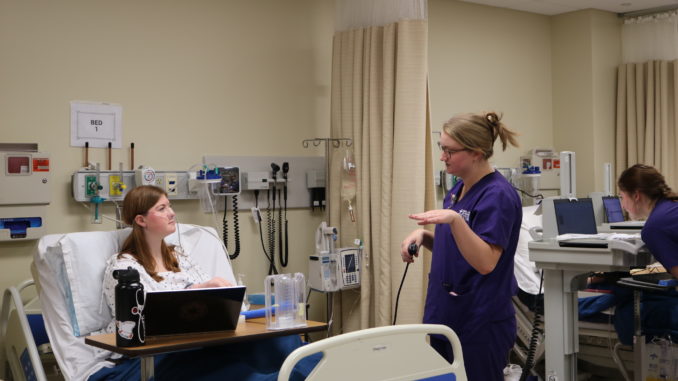
Truman State University nursing seniors completed a 72-hour simulation of a hospital setting which began Thursday, March 23, the first 72-hour simulation completed by Truman students since the pilot program during 2020.
Students worked the equivalent of three 12-hour shifts, from either 6 a.m. to 6 p.m. or 6 p.m. to 6 a.m, with one day shift being split between Thursday and Sunday. Each student worked a total of 36 hours.
The simulation occurred in the two nursing labs – the nursing simulation center in the Health Sciences building was a medical-surgical unit and the nursing skills lab in the Pershing building served as an emergency department, said Brenda Wheeler, nursing department chair
Nursing students who were juniors or below volunteered for extra credit to participate as patients who had scripted injuries or illnesses for the nursing students to address. The 45 seniors spent half the time as nurses in the simulation and half their time as patients.
Additionally, there were a few community members with connections to the nursing department who volunteered for the simulation. Some served as patients and some as family members in order to teach the students how to deal with family members of patients. Any invasive procedures were done on mannequins.
“What this really does is it gives students an idea what it’s like to really be working on their own, to be responsible for more than one patient on their own,” Wheeler said.
Currently, when students are working in a real hospital they have a preceptor or instructor guiding them, so they are not the ones ultimately making decisions about the patients. For the simulation, instructors were present but were not contributing to students’ decision-making, Wheeler said.
Senior nursing student Grace James said this simulation was closer to a hospital setting, different from their usual simulations. James said the students would spend six hours as a patient and six hours as a nurse.
Her shift as a charge nurse went well and she felt prepared, James said. While students have worked 12-hour shifts before at externships, this was multiple longer shifts in a row which built stamina.
“Yeah I definitely feel like it’s been a good experience just because even though like we have clinicals all throughout the year in different places it’s not the same when you’re just following a nurse and you’re not actually getting to document everything so I feel like this has been a really good simulation of what it would be like in the real world,” James said.
Junior nursing student Sasha Thomas volunteered for the simulation and said she was still able to learn things even as a patient.
The idea came from Connie Ayers, who was the head of nursing at Truman until 2000, said Wheeler. Ayers’ husband, Andy, worked for NASA and trained astronaut crews. He worked with Ayers to design the simulation. The simulation was done at Texas Woman’s University, where they brought together other healthcare disciplines to complete the simulation.
They formed a company, SCHOLAR, which provides simulation-based clinical and hospital learning for accelerated readiness. They provide consulting to universities wanting to design their own 72-hour simulations.
Wheeler said this was the first time SCHOLAR had written a script as extensive as the two scripts used for this simulation. This was the hardest simulation written and Ayers was very proud of it, Wheeler said.
Nursing foundation funds were used to pay for the consulting, Wheeler said. This covered the cost of setting up and running the simulation, as well as transportation and lodging for the SCHOLAR team.
For Truman’s simulation, each student had two patients each of a higher acuity, or higher physical and mental health needs.
The simulation was scripted. Ayers came to the simulation and brought nurse practitioners who were available for students to consult as a care provider, just like in a real medical setting.
“This is going to be a really intense, very good learning experience for the students. I’m sure the first, their first shift, students are going to feel like a fish out of water. I would suspect their next shift, they’re going to begin to say, ‘OK, I think I kind of get this,’” Wheeler said.
Wheeler said one of the reasons they wanted to do the simulation was because new graduates often say they didn’t feel prepared for their jobs. There’s only so much the nursing department can do unless the students are completely on their own. This is as close to a real hospital environment as the department can get.
